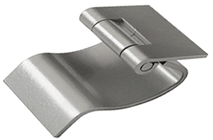
Have you heard of self-closing hinges? Like all hinges, they are used to connect two objects while allowing at least one of the objects to rotate. You can find them on doors, gates and even furniture. Self-closing hinges, however, are unique from all other types of hinges. For a better understanding of self-closing hinges and how they work, keep reading.
What Are Self-Closing Hinges?
Self-closing hinges live up to their namesake by closing automatically. As previously mentioned, hinges allow objects to rotate. You can rotate a hinge-connected door by pulling it open. Depending on the type of hinge with which it’s connected, the door may or may not remain open. If it’s connected with a traditional hinge, it will remain open until you manually close it. If the door is connected with a self-closing hinge, on the other hand, it will close automatically without requiring intervention on your behalf.
Other objects can be connected with self-closing hinges as well. While they are most commonly used to connect doors, they can connect gates, panels and other solid objects. Self-closing hinges simply close automatically, which is how they are distinguished from other types of hinges.
How Self-Closing Hinges Work
Most self-closing hinges work by exerting a small amount of force that pulls the connected object back to its default and closed position. They still have two leafs, which are joined together at the center to form a knuckle. The knuckle, however, is typically spring-loaded. Other types of hinges typically only have a pin in the knuckle. Self-closing hinges, conversely, have a spring, which they use to pull and close objects.
Self-closing hinges are able to close automatically by using a spring. They have a spring within the knuckle that pulls the connected object. When you open a door connected with a self-closing hinge, the enclosed spring will stretch. Stretching, of course, creates tension. The self-closing hinge will then pull the door back to its closed position automatically as the enclosed spring attempts to relieve this tension. Self-closing hinges are available in other designs, but most of them rely on a spring. The presence of a spring within the knuckle allows them to close on their own.
In Conclusion
Hinges are classified as self-closing if they close automatically. Most of them have a spring within the knuckle. The spring will stretch as the connected object rotates. In response, the self-closing hinge will pul the connected object back to its closed position.
